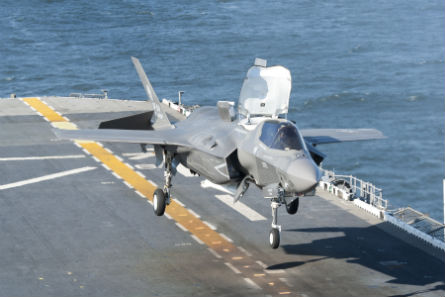A special review by the US Department of Defense has identified 13 ongoing or likely future design problems with the Lockheed Martin F-35 and recommended further cuts during early production.
The "concurrency quick look review", dated 29 November, is timed to influence the DoD's final reviews for the contracting fiscal year 2013 budget, with the F-35 programme facing a production freeze after peaking so far at 34 aircraft in 2010.
The review discovered no "fundamental design risks" large enough to recommend halting new F-35 production altogether, according to the 20-page report, which is stamped "[for official use only] - US only" and signed by five DoD officials, led by deputy assistant secretary of defense for strategic and tactical systems David Ahern.
But the report identifies and provides new details of eight design problems described as "major" risks and five design problems classified as minor risks.
 |
|---|
| © Lockheed Martin |
Moreover, Lockheed still has 577 change order requests pending from previous design changes, representing an 18- to 24-month backlog that must be cleared before dealing with fixes for the new design problems, the report said.
The backlog of change orders and the ongoing design problems prompted the review team to challenge the F-35's "concurrent" acquisition strategy, which calls for building hundreds of jets during the decade between first flight in 2006 and the end of development after 2016.
The most challenging phase of the flight test schedule, which includes high angle-of-attack flight, mission systems and weapons release, lies ahead.
As a result, the review team "recommends that further decisions about F-35 production be event driven, based on the achievement of sufficient test data to support increased confidence in design maturity and of a well-controlled process for executing and minimizing design changes across concurrent production", the report said.
Among the eight major design problems, one is classified and not described in the leaked version of the review team's report.
The helmet-mounted display, fuel dump subsystem, integrated power package and arresting hook for the carrier-based F-35C variant remain "major" problems with no root cause or permanent fix identified so far.
The review also found three areas where major problems are "likely", but have not yet been fully studied in ground or flight tests. These include sharp buffeting at high angles of attack, the discovery of more life-limited parts and the minimal tests completed.
Finally, the review also identified five areas with "moderate" risk of increasing production costs as new areas are discovered in development. Software, weight management, thermal concerns, the autonomic logistics information system and lightning protection are on the list.
The review's findings appear to show the five major problems identified last year with the F-35B short take-off and vertical landing variant have been resolved or entered the backlog of change requests.
Source: Flight International



















